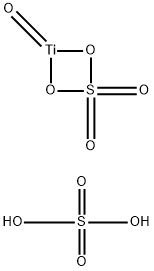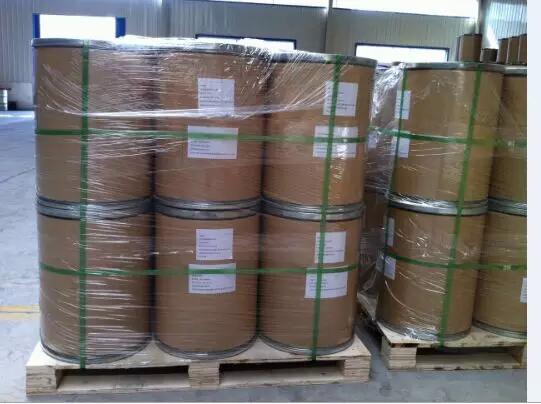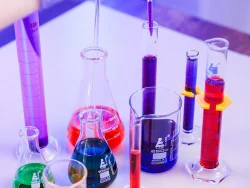Vanadyl sulfate
- CAS NO.:27774-13-6
- Empirical Formula: O5SV
- Molecular Weight: 163
- MDL number: MFCD00149935
- EINECS: 248-652-7
- SAFETY DATA SHEET (SDS)
- Update Date: 2024-12-18 14:08:52

What is Vanadyl sulfate ?
Chemical properties
Vanadyl sulfate is a pale blue crystalline powder. It is odorless and very soluble in water. It is denser than water. Contact may irritate skin, eyes, and mucous membranes. It may be toxic if ingested, inhaled, or absorbed through the skin.
Physical properties
The dihydrate, VOSO4.2H2O is a blue black crystalline powder, soluble in water.
The Uses of Vanadyl sulfate
The dihydrate is a mordant in dyeing and printing fabrics; used in preparing aniline black; a colorant in ceramics to form blue and green glazes; used in making colored glass; and a reducing agent.
Definition
ChEBI: Vanadyl sulfate is a vanadium coordination entity and a metal sulfate.
Preparation
Vanadyl sulfate is prepared by passing sulfur dioxide through a cold solution of vanadium pentoxide in sulfuric acid, followed by crystallization:
V2O5 + H2SO4 + H2O + SO2 → 2VOSO4 + 2H2O
General Description
Vanadyl sulfate is a sulfate of vanadium that occurs naturally as the mineral pauflerite. It is a common source of vanadium in the laboratory. Vanadyl sulfate is an intermediate in the extraction of vanadium from petroleum residues and is also a component of some food supplements and drugs. Vanadium is a transition metal with the chemical symbol V and atomic number 23. The element usually combines with other elements such as oxygen, sodium, sulfur, or chloride, and occurs naturally in about 65 different minerals and in fossil fuel deposits. Vanadium is found in many organisms, and is used by some life forms as an active center of enzymes. (L837, L838, L852)
Reactivity Profile
Vanadyl sulfate has weak oxidizing or reducing powers. Redox reactions can however still occur.
Health Hazard
Highly toxic, may be fatal if inhaled, swallowed or absorbed through skin. Avoid any skin contact. Effects of contact or inhalation may be delayed. Fire may produce irritating, corrosive and/or toxic gases. Runoff from fire control or dilution water may be corrosive and/or toxic and cause pollution.
Fire Hazard
Non-combustible, substance itself does not burn but may decompose upon heating to produce corrosive and/or toxic fumes. Containers may explode when heated. Runoff may pollute waterways.
Flammability and Explosibility
Non flammable
Safety Profile
A poison and an inhalation hazard. Poison by intravenous, intraperitoneal, and subcutaneous routes. Mutation data reported. When heated to decomposition it emits toxic fumes of VOx and SOx. See also SULFATES and VANADIUM COMPOUNDS.
Potential Exposure
Vanadyl sulfate is used as a fixative for textile dyes, a colorant for glass and ceramics; a reducing agent and a catalyst.
Shipping
UN2931 Vanadyl sulfate, Hazard Class: 6.1; Labels: 6.1-Poisonous materials.
Incompatibilities
Vanadyl sulfate has weak oxidizing or reducing powers. Redox reactions can however still occur. Incompatible with oxidizers (chlorates, nitrates, peroxides, permanganates, perchlorates, chlorine, bromine, fluorine, etc.); contact may cause fires or explosions. Keep away from alkaline materials, strong bases, strong acids, oxoacids, epoxides. Vanadyl sulfate may attack metals; sulfates react with aluminum, magnesium.
Properties of Vanadyl sulfate
| Melting point: | 105°C |
| Density | 2.06[at 20℃] |
| solubility | soluble in H2O |
| form | Solid |
| color | Blue |
| Water Solubility | soluble |
| Stability: | Stable. Incompatible with strong oxidizing agents. |
| CAS DataBase Reference | 27774-13-6(CAS DataBase Reference) |
| EPA Substance Registry System | Vanadyl sulfate (27774-13-6) |
Safety information for Vanadyl sulfate
| Signal word | Warning |
| Pictogram(s) |
 Exclamation Mark Irritant GHS07 |
| GHS Hazard Statements |
H315:Skin corrosion/irritation H319:Serious eye damage/eye irritation |
| Precautionary Statement Codes |
P280:Wear protective gloves/protective clothing/eye protection/face protection. P302+P352:IF ON SKIN: wash with plenty of soap and water. P305+P351+P338:IF IN EYES: Rinse cautiously with water for several minutes. Remove contact lenses, if present and easy to do. Continuerinsing. P332+P313:IF SKIN irritation occurs: Get medical advice/attention. P337+P313:IF eye irritation persists: Get medical advice/attention. |
Computed Descriptors for Vanadyl sulfate
New Products
4,4-Difluoropiperidine hydrochloride tert-butyl 9-methoxy-3-azaspiro[5.5]undecane-3-carboxylate Indole Methyl Resin N-Isopropylurea N,N-Dicyclohexylcarbodiimide(DCC) MELDRUMS ACID 5-METHYLISOXAZOLE-4-CARBOXYLIC ACID Magnessium Bis glycinate Zinc ascorbate 1-bromo-2-butyne 2-acetamidophenol 9(10H)-anthracenone Erythrosin B, 4-Piperidinopiperidine 2-((4-morpholinophenylamino) (methylthio) methylene) malononitrile 2,4-dihydroxybenzaldehyde 3-(4-morpholinophenylamino)-5-amino-1H-pyrazole-4-carbonitrile Methyl 2-methylquinoline-6-carboxylate 2,6-dichloro-4-nitropyridine 4-Bromo-2-chlorobenzonitrile 2-(benzylamino)acetic acid hydrochloride 4-(tert-Butoxycarbonylamino)but- 2-ynoic acid 3,4-dihydro-2H-benzo[b][1,4]dioxepine 1-Phenyl-1-cycloprppanecarboxylicacidRelated products of tetrahydrofuran








You may like
-
 27774-13-6 Vanadyl sulfate 99%View Details
27774-13-6 Vanadyl sulfate 99%View Details
27774-13-6 -
 Vanadyl sulfate 27774-13-6 98%View Details
Vanadyl sulfate 27774-13-6 98%View Details
27774-13-6 -
 VANADYL SULPHATE Pentahydrate Extra Pure CAS 27774-13-6View Details
VANADYL SULPHATE Pentahydrate Extra Pure CAS 27774-13-6View Details
27774-13-6 -
 VANADYL SULFATE CAS Number: 27774-13-6View Details
VANADYL SULFATE CAS Number: 27774-13-6View Details
27774-13-6 -
 3-(4-amino-1-oxoisoindolin-2-yl)-1-methylpiperidine-2,6-dione 98%View Details
3-(4-amino-1-oxoisoindolin-2-yl)-1-methylpiperidine-2,6-dione 98%View Details -
 20677-73-0 (2,2-diethoxyethyl)methylamine 98%View Details
20677-73-0 (2,2-diethoxyethyl)methylamine 98%View Details
20677-73-0 -
 3-(4-(hydroxyamino)-1-oxoisoindolin-2-yl)piperidine-2,6-dione 98%View Details
3-(4-(hydroxyamino)-1-oxoisoindolin-2-yl)piperidine-2,6-dione 98%View Details -
 57381-49-4 2-bromo-4-chlorobenzonitrile 98%View Details
57381-49-4 2-bromo-4-chlorobenzonitrile 98%View Details
57381-49-4
